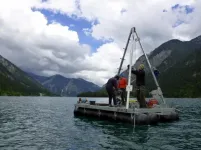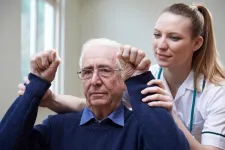Past earthquakes triggered large rockslides in the Eastern Alps
2021-02-16
(Press-News.org) Many steep valleys in the European Alps show the relicts of large rockslides, during which several hundreds of million cubic metres of rocks get instable, collapse and impact everything on their path. "For most of these, we still do not know how they are caused, because these rockslides occurred long before the start of written history in the region about 1000 years ago," says Patrick Oswald, PhD student at the Department of Geology of the University of Innsbruck and lead author of the study. "Curiously, many of these ancient rockslides occurred together in clusters, meaning they are found in small regions and have a rather comparable age". This enigmatic pattern has puzzled researchers over the last decades and fuelled some intense debates. Some experts propose that abrupt climate shifts can degrade rock slopes towards unstable conditions, whereas others think that strong earthquake shaking is the main driver. Such problems are notoriously difficult to solve, as the object of study - the rock slope - has collapsed and cannot be investigated anymore. Therefore, the research team decided to turn the perspective around and searched underwater for answers to these questions. "The different sediment layers that are deposited year after year on the bottom of our lakes and oceans provide long-term information on climatic and ecological conditions, but also record the disturbances induced by strong earthquake shaking that happened long ago, in the prehistoric past," says Michael Strasser, head of the Sedimentary Geology working group at the Department of Geology and the Austrian Core Facility for scientific core analysis at the University of Innsbruck.
Severe prehistoric earthquakes
The geologists focused on two of the most massive rockslides of Tyrol, the Tschirgant and the Fernpass. "Instead of investigating the remnants of these rockslides in the landscape, we drilled into the muddy sedimentary archives on the bottom of the lakes Piburgersee and Plansee in the region and searched for specific traces that could tell us when strong earthquakes took place," explains Jasper Moernaut from the Department of Geology, head of the project this study is based on, "Tyrol on Shaky Slopes". "By comparing the earthquake and rockslide reconstructions for the past 10,000 years, we can evaluate whether these relate to each other, or not." By applying state-of-the-art techniques, such as hydroacoustic profiling of the lake's subsurface or computer-tomography scans of the 8 m long sediment cores, the researchers found two different types of earthquake traces in the sediments: Strong seismic shaking has deformed surficial sediments on the bottom of the lakes and also triggered numerous underwater mud avalanches. By radiocarbon dating of organic matter in the cores, this research discovered ten prehistorical earthquakes during the past 10,000 years. The ground shaking associated to these earthquakes was stronger than for those that have struck the region in the past ~1000 years. "Through a painstaking evaluation of historical earthquake reports and comparison with the sedimentary imprints in the lakes, we estimated the earthquake magnitudes to be M5.5 to 6.5," says Christa Hammerl, a historical seismologist at the Austrian Central Institute for Meteorology and Geodynamics. "As the earthquakes in the Eastern Alps occur at only a few kilometres depth, such earthquakes can produce considerable damage on infrastructure and the natural landscape."
Rockslide clusters triggered by earthquakes
Strikingly, the ages of two extraordinary strong earthquakes coincide very well with those of multiple large rockslides around 3,000 and 4,100 years ago. This age coincidence let the geologists deduce that extreme seismic shaking ultimately triggered the rockslides at these times, solving the debate on the cause of rockslide clusters in the region. Since then, no large rockslides or such extraordinary strong earthquakes struck the area. The results also indicate that a close succession of at least five severe earthquakes preceded the rock slope collapses at about 3,000 years ago. "Therefore, we propose that seismic shaking cannot only trigger rockslides, but can also gradually degrade the rock slopes towards their critical tipping point," explains Michael Strasser. "With all this new information, the challenge now lies in its implementation for better assessing future earthquake and rockslide hazards in the densely populated Alpine valleys. An adequate mitigating of such low probability but high impact events forms a big challenge. Knowledge about these past events can help better understand earthquake occurrence and provide key information for assessing future earthquake- and rockslide hazard."
INFORMATION:
This research is supported by the European Regional Development Fund Interreg V-A Italy-Austria 2014-2020 (project ITAT3016-Armonia), the Tyrolean Science Fund (project UNI-0404-2151), the Austrian Science Fund FWF (project P30285-N34) and the Austrian Academy of Sciences ÖAW (ESS-IGCP-project S4LIDE-Austria).
Publication:
Seismic control of large prehistoric rockslides in the Eastern Alps. Patrick Oswald, Michael Strasser, Christa Hammerl, Jasper Moernaut. Nature Communications 2021.
DOI: 10.1038/s41467-021-21327-9
https://doi.org/10.1038/s41467-021-21327-9
Links:
Sedimentary Geology Working Groupat the Department of Geology: https://www.uibk.ac.at/geologie/sediment/
Austrian Central Institute for Meteorology and Geodynamics: https://www.zamg.ac.at/cms/de/geophysik/erdbeben
[Attachments] See images for this press release:

ELSE PRESS RELEASES FROM THIS DATE:
2021-02-16
"Thin films are solid state substances that can be only several atomic layers thick. Usually, their properties are considerably different from the properties of the original substances on the macroscale. The areas of their application keep expanding and include nanoelectronics, optoelectronics, spintronics, electro-, and photocatalysis, as well as such important fields of economics as space technologies and instrument building. Micromodule devices for space crafts and medical technologies are also promising areas in which thin films can be used," said Vyacheslav Fominski, a project supervisor representing MEPhI.
To reduce friction and solve many ...
2021-02-16
Cataracts are the most common eye ailment in humans. However, the exact processes leading to this condition are not fully understood. A team of researchers headed by the Technical University of Munich (TUM) has now discovered that the composition of the protein solution plays a decisive role. Their conclusions are contrary to prevailing opinion in the field.
The cells in the lens consist of a highly concentrated protein solution that is normally clear. "When the balance of the proteins in the lens is destroyed, they clump together and the lens becomes cloudy," says Prof. Johannes Buchner of the Chair of Biotechnology at TUM. This results in the condition known as cataracts.
The clouding can have different causes. Because the proteins in the lens are formed ...
2021-02-16
The 'sloshing' of a quantum fluid comprised of light and matter reveals superfluid properties.
An Australian-led team of physicists have successfully created sloshing quantum liquids in a 'bucket' formed by containment lasers.
"These quantum fluids are expected to be as wavy as the oceans, but catching clear pictures of the waves is an experimental challenge," says lead author Dr Eliezer Estrecho.
Led by the Australian National University (ANU), the team serendipitously observed the wavy motion of the quantum fluid in an optically-controlled bucket, gaining new insights of the intriguing superfluid properties of this peculiar, hybrid light-matter system.
Superfluidity ...
2021-02-16
The processes in living beings follow a finely orchestrated choreography down to the molecular level. Rhythmic processes are found everywhere in biology, for example, the 24-hour circadian cycle, a kind of "internal clock", plays an important role in regulating many processes in living cells, including metabolism and cell division mechanisms.
Scientists from Saarbrücken and Kaiserslautern have now taken a closer look at a similar cycle, the somewhat shorter ultradian cycle of baker's yeast. Under the leadership of Bruce Morgan, Professor of Biochemistry at ...
2021-02-16
Combining healthy lifestyle interventions reduces heart disease through beneficial effects on different lipoproteins and associated cholesterols, according to a study published February 9 in eLife.
Having a healthy lifestyle has long been associated with a lower risk of developing heart disease. The new study provides more detailed information on how healthy lifestyles improve cholesterol, and suggests that combining cholesterol-lowering medications and lifestyle interventions may yield the greatest benefits to heart health.
Cholesterol-lowering ...
2021-02-16
The fact that cells are motile and come into contact with each other is one of biology's fundamental principles. During embryonic development, cells must communicate with their neighbors in order to find their proper place in the differentiating organism. Wound healing is another process in which direct intercellular interactions are essential. In this context, motility enables cells to migrate to the location of the lesion and regenerate lost structures. Cancer cells also make use of this property to leave their site of origin in the primary tumor, which allows them to initiate the formation of metastatic tumors in other tissues.
"In recent years, biologists ...
2021-02-16
An international study has shown, for the first time, that the capacity of the human brain to recover and rewire itself peaks around two weeks after a stroke and diminishes over time.
The finding, published today in the Neurorehabilitation and Neural Repair journal, is the result of a study in London and Adelaide that followed the recovery of 60 stroke patients up to one year after their stroke.
Lead author Dr Brenton Hordacre, from the University of South Australia, says the multi-site study showed conclusive evidence that the brain only has a small window of opportunity to more easily repair itself after stroke.
"Earlier animal studies suggested ...
2021-02-16
Icebergs are melting faster than current models describe, according to a new study by mathematicians at the University of Sydney. The researchers have proposed a new model to more accurately represent the melt speed of icebergs into oceans.
Their results, published in Physical Review Fluids, have implications for oceanographers and climate scientists.
Lead author and PhD student Eric Hester said: "While icebergs are only one part of the global climate system, our improved model provides us with a dial that we can tune to better capture the reality of Earth's changing climate."
Current models, which are incorporated into the methodology used by the Intergovernmental Panel on Climate Change, ...
2021-02-16
Over the past years, global data traffic has experienced a boom, with over 12.5 billion connected devices all over the world. The current world-wide deployment of the 5G telecommunications standard is triggering the need for smaller devices with enhanced performances, such as higher speed, lower power consumption and reduced cost as well as easier manufacturability.
In search for the appropriate technology, photonic devices emerged as the leading technology for the evolution of such information and communication technologies, already surpassing ...
2021-02-16
ADELPHI, Md. -- The Army of the future will involve humans and autonomous machines working together to accomplish the mission. According to Army researchers, this vision will only succeed if artificial intelligence is perceived to be ethical.
Researchers, based at the U.S. Army Combat Capabilities Development Command, now known as DEVCOM, Army Research Laboratory, Northeastern University and the University of Southern California, expanded existing research to cover moral dilemmas and decision making that has not been pursued elsewhere.
This research, featured in Frontiers in Robotics and AI, tackles the fundamental challenge of developing ethical artificial intelligence, ...
LAST 30 PRESS RELEASES:
[Press-News.org] Past earthquakes triggered large rockslides in the Eastern Alps



